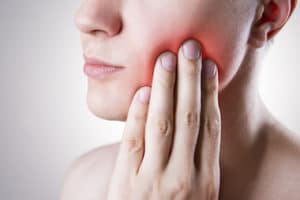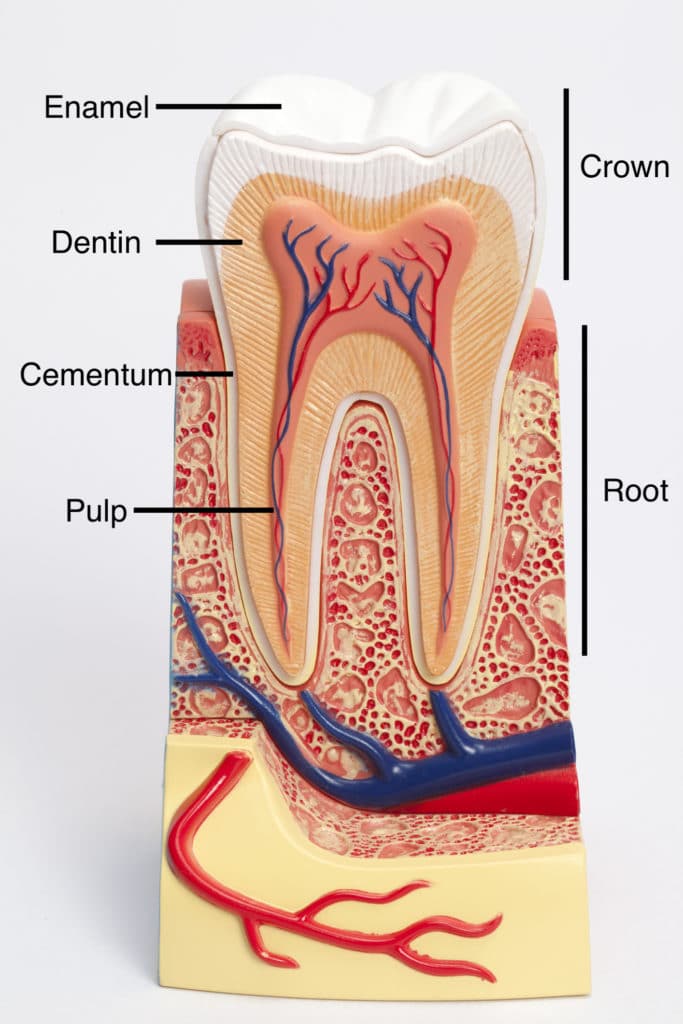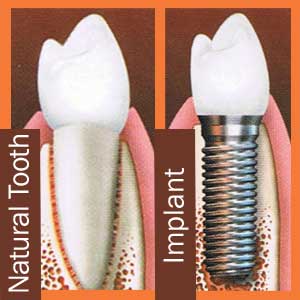Most people probably don’t think of their teeth as living tissue, and may be surprised to learn that teeth can die. But what is a dead tooth? How can a tooth die? And can it be prevented? If you suspect you have a dead tooth, there are measures you can take to save it.
What is a Dead Tooth?
A dead tooth no longer receives blood because the tooth root is damaged or severed. Without blood flow, the cells in the tooth begin to die. A dead tooth might also be called non-vital, or the condition might be called pulp necrosis (death of the tooth pulp).
Is a Tooth Alive?

It may surprise you, but teeth are actually living tissue. The tooth root is an essential inner structure within every tooth. This structure is deep within the center of the tooth, underneath tougher layers of enamel, dentin and cementum. Enamel, which is the tough outer layer of the tooth, is not a living part of the tooth. Since this is the only tooth structure that is visible, this is why we generally don’t think of teeth as alive. However, the dentin underneath and the cementum around the lower portion of the tooth, hidden by the gums, are both made of living tissue. Underneath these layers is the tooth root, which is filled with dental pulp and contains nerves, blood vessels, connective tissue and other important elements.
Parts of a Tooth
Enamel: This is the outside covering of the tooth crown, the visible portion of the tooth. It’s made mostly made of calcium phosphate and, though it’s not living and can’t regenerate like other body tissues, fluoride bonds with the calcium phosphate to strengthen it and prevent decay. This is why fluoride treatments are provided for children, and why water and some foods are fluoridated around the world.
- Dentin: Underneath the enamel and surrounding the tooth root is dentin. Dentin makes up the majority of the tooth and it resembles bone. Like bone, dentin is living tissue that can regenerate over time.
- Cementum: This is a relatively thin layer between the dentin and the gums. As the name implies, it “cements” the tooth in place and keeps it stable with many small fibers.
- Tooth Roots: The tooth roots extend into the gums and connect the tooth to the jaw bone. Tooth roots contain dental pulp, covered by a layer of dentin and then by cementum.
- Dental Pulp: This part of the tooth is very important; it supplies blood flow to the tooth and keeps living structures healthy. The nerve endings of the tooth also live here, which allow you to “feel” your teeth. If this part of the tooth becomes damaged, it can be very painful. Dental pulp resides in the root canal, a naturally-occurring space deep within teeth.
Except for enamel, all the tissues inside a tooth can heal themselves like other body tissues, as long as they are not overwhelmed with bacteria or the injury is not too great. If this happens, the tooth can die.
How Does a Dead Tooth Happen?
Since a dead tooth is the result of severe damage to the tooth pulp and a loss of blood flow, a dead tooth can occur when the tooth root is severely damaged. This can happen through an infection or through a hard impact to the tooth or jaw.
- Infection: A dental cavity (or cary) occurs when bacteria eats a small hole in tooth enamel and starts to eat away at the inner structures, like the dentin. If a cavity isn’t treated, bacteria can make their way all the way to the tooth pulp and destroy it. In this case, the tooth can become infected, and many other symptoms will appear.
- Hard impact: A tooth root can be damaged and a dead tooth can also occur from a heavy blow to the jaw, such as a sports injury or even a slip and fall accident. If the tooth root fractures from the hit, it can damage the pulp and stop blood flow to the tooth.
If you have intense jaw or tooth pain, you may have a serious infection, which can be life-threatening. If you are near Las Vegas, Henderson or Laughlin, Nevada, or Lake Havasu, Arizona, call us at (702) 388-8888 or schedule an appointment with Boston Dental Group for emergency dental care.
Do I Have a Dead Tooth? Symptoms to Look For

Symptoms of a dead tooth:
- Tooth is discolored
- Swollen, puffy gums
- Jaw pain
- Abscess
- Persistent bad breath
- Persistent bad taste in mouth
- Tooth feels loose
Will a Dead Tooth Come Out on its Own?
As the tooth dies, the structures anchoring it to your mouth also weaken. This means the tooth will eventually fall out on its own. However, this can also mean a bacterial infection has grown significantly, and can endanger other teeth, even other parts of your mouth and face. A tooth infection can eventually lead to sepsis or it can even infect the brain, both which are life-threatening conditions. If you have a dead tooth or you have pain around a tooth that may be damaged, see a dentist right away. This problem will not get better on its own, and will likely get much worse.
Can a Dead Tooth Be Saved?
A dead tooth can be saved, and does not have to be extracted. Though an emergency extraction and cleaning will help to stop the spread of bacteria, this can also be accomplished without removing the tooth. The process of saving a tooth is similar to cleaning an infected wound. First, the dentist will remove the infected tissue within the tooth and tooth root (the root canal). Then, the dentist will fill the empty space and close the root canal, so the infection doesn’t return. This is a bit like cleaning and bandaging a wound. Antibiotics might also be stop the infection, whether you have a root canal procedure or an extraction.
If you have a dead tooth, you will need one of the following procedures:
- Extraction: Removing the dead tooth will take some of the bacteria with it. Antibiotics or thorough cleaning can eliminate the rest. The tooth can be replaced with an implant, if you choose.
- Root canal therapy: By cleaning out the dead tooth pulp and infected tissue, then filling the space, you can keep the tooth while eliminating bacteria. Antibiotics and a thorough cleaning may also be required.
Keep in mind that only a dentist can say for sure whether or not the tooth is dead. An exam and x-ray will give the dentist more information, and they can explain treatment options. If you are concerned about dental costs, ask about payment plans. Remember that a dental exam and tooth extraction now will be less expensive than emergency medical care resulting from an untreated infection.
If you are near Las Vegas, Henderson or Laughlin, Nevada, or Lake Havasu, Arizona, call us at (702) 388-8888 or schedule an appointment with Boston Dental Group. We accept most insurance plans, and can provide the financing you need in the event of a dead or dying tooth.

 Enamel: This is the outside covering of the tooth crown, the visible portion of the tooth. It’s made mostly made of calcium phosphate and, though it’s not living and can’t regenerate like other body tissues, fluoride bonds with the calcium phosphate to strengthen it and prevent decay. This is why
Enamel: This is the outside covering of the tooth crown, the visible portion of the tooth. It’s made mostly made of calcium phosphate and, though it’s not living and can’t regenerate like other body tissues, fluoride bonds with the calcium phosphate to strengthen it and prevent decay. This is why 